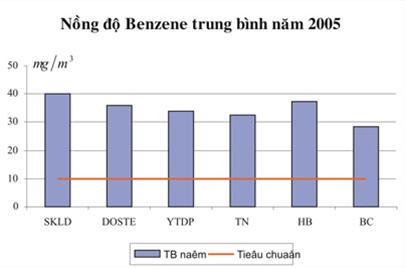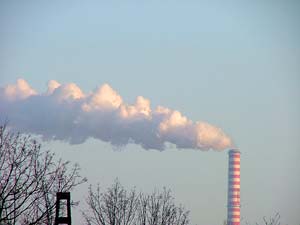At the scientific conference on the impact of air pollution held on May 23rd, experts raised alarms about the concerning levels of air pollution in Ho Chi Minh City, particularly the increasing concentrations of harmful substances in the air such as benzene and nitrogen oxides…
According to Master’s degree holder Le Van Khoa, Deputy Head of the Environmental Protection Department in Ho Chi Minh City, the overall picture of air pollution in the city shows that the concentration of several pollutants exceeds permissible standards for both ambient air quality (residential areas) and roadside air quality.
Mr. Khoa emphasized that the concentration of PM10 particulate matter (particles smaller than 10 micrometers) in residential areas has been on the rise in recent years. In some areas, the PM10 concentration has reached over 80 micrograms/m3, while the permissible standard is significantly lower than this figure.
 |
(According to the standards of the U.S. Environmental Protection Agency) |
Similarly, the standard for sulfur dioxide (SO2) based on monitoring results shows that while the concentrations of this pollutant have not exceeded permissible limits, they have been increasing in recent years. In some areas of Ho Chi Minh City, SO2 concentrations have reached about 30 micrograms/m3.
However, experts point out that the particularly high levels of extremely toxic pollutants require special attention. Master Le Van Khoa noted that 2005 marked the first year Ho Chi Minh City began monitoring benzene levels in the air across various areas of the city.
Monitoring results from six locations revealed that benzene concentrations in some places reached 35-40 micrograms/m3, while the permissible level according to the U.S. Environmental Protection Agency is only 10 micrograms/m3 (Vietnam currently lacks standards for this toxic substance in the air).
In an interview with Tuoi Tre, Mr. Khoa explained that the high benzene levels in the air are attributed to fuel and transportation activities. Among the six monitoring points for benzene in Ho Chi Minh City, the intersection of Dien Bien Phu and Dinh Tien Hoang in District 3, District 5… reported the highest concentrations.
“The recorded benzene concentration levels in Ho Chi Minh City indicate that pollution from this toxic substance has reached alarming levels,” Mr. Khoa emphasized, noting that it is a substance continuously warned to have a high cancer risk.
Increase in Various Illnesses
Dr. Ha Manh Tuan, Deputy Director of Children’s Hospital 1 in Ho Chi Minh City, also spoke out, stating that diseases such as pneumonia, otitis media, and asthma are on the rise and are related to air pollution.
Dr. Tuan indicated that Districts 8, 11, Tan Binh, and Binh Chanh… have a high incidence of respiratory diseases (over 6% of total respiratory cases requiring examination and treatment at Children’s Hospital 1), with District Tan Binh having the highest rate at over 16% of total cases.
 |
| Smoke stacks and incinerators related to air pollution (Photo: fizyka.phys) |
By analyzing these statistics, experts believe that densely populated areas with high traffic density, especially with rampant industrial activities, are where the rates of respiratory illnesses are notably high, with some areas reporting extremely high levels.
Meanwhile, Dr. Huynh Tan Tien, Director of the Occupational and Environmental Health Center in Ho Chi Minh City, revealed that in 2005, the center discovered over 300 dust samples and 58 chemical samples exceeding permissible limits, potentially causing occupational diseases at enterprises in the leather, rubber, and cosmetics industries…
Dr. Tien emphasized the need for proper attention to the environment around tobacco factories and their vicinity, as the activities of this industry accumulate many different toxic chemicals… “Occupational diseases caused by air pollution are still quite high, and some diseases leave lifelong complications that are very difficult to treat,” Dr. Tien warned.
From another perspective, Mr. Nguyen Dinh Tuan, Head of the Environmental Protection Department in Ho Chi Minh City, stated that the goal of the air pollution reduction program aims to bring pollutant concentrations such as sulfur oxides and carbon oxides down to standard levels by 2010.
Mr. Tuan also candidly criticized the environmental standards testing for vehicles in Vietnam, noting many shortcomings, while the inspection and sanctioning of vehicles violating environmental standards have hardly been implemented; improvements in fuel quality have mainly stopped at eliminating leaded gasoline…
Moreover, Mr. Tuan acknowledged that the environmental standard registration process is still largely formalistic. This mandatory activity for businesses and production facilities only performs well during the assessment phase, while the follow-up inspection processes are almost neglected.




















































